All 4 entries tagged Methodology
View all 77 entries tagged Methodology on Warwick Blogs | View entries tagged Methodology at Technorati | There are no images tagged Methodology on this blog
October 27, 2009
A research methodology using Mindmanager concept mapping & design thinking
In this entry I describe how I am using technology to support my iterative design-thinking based research process.
My approach is based upon the "design thinking" methodology. The process works as iterations of "inspiration, ideation, implementation" in which an initial emphasis upon "inspiration" shifts (but not completely) through time towards an emphasis upon "implementation":
- Being inspired by the work of other researchers and practitioners, along with first-hand encounters in the world (in teaching, learning, design etc);
- Abstracting from this concepts, propositions, variables, etc;
- Creating conjectures about the world (or in design-language "prototypes") based upon those ideas;
- Creating opportunities to realistically test those conjectures;
- Reporting upon the success or failure of the conjectures, and their implications;
- Forming further iterations and directions for research.
I record my research activities upon a concept map (using the sophisticated Mindmanager mapping tool), in a Warwick Blogs blog (linked to from within the map, and keyword tagged using the same schema as the map), and as annotations on pdf files (using a Mac, searchable with Spotlight). The map is structured at the top level as follows:
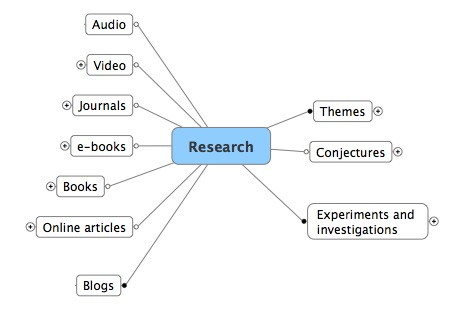
The left-hand side of the map records my readings, along with videos and audio podcasts. Further "inspiring" events and materials are recorded on my Inspires Learning blog, and tagged as "inspiration" (to be added to the map shortly). I like to group my readings together according to source, as this gives me a sense of where I am finding good materials. For example, the Journals node already indicates sources that I am finding to be rich in useful materials:

Opening up the Books node reveals how I am working through the contents of some key books chapter by chapter. I will often write a review of each chapter in my blog. Records in the blog are linked to such literature review blog entries. See how I have added a "task completion" counter to the "Developing Creativity in Higher Education" book, indicating my progress through the book. I will be making further use of icon tagging and task tagging to manage the process. Some of the nodes (especially in Journals and e-Books) contain actual electronic articles as attachments.
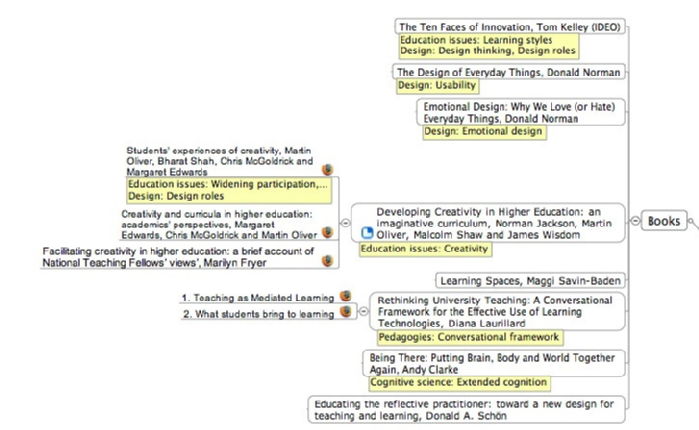
You can also see how each item of literature is being classified using a range of text tags. For example, one article is tagged as being relevant to the "widening paricipation" issue. This keyword tag schema is being developed in the Themes section on the right hand side of the map. I have organised my concepts, issues etc in the following top-level categories:

Opening up the Education Issues node reveals the issues that I am investigating. These issues guide my research process - anything that can have a positive impact here is more worthwhile. I can also assess the impact of conjectures and their consequent practices against their impact on these issues:

The Design node reveals the concepts taken from the design industry that I am porting across to education. I can use this to unveil the novelty of these approaches, as well as seeking connections in existing pedagogical practice and theory.
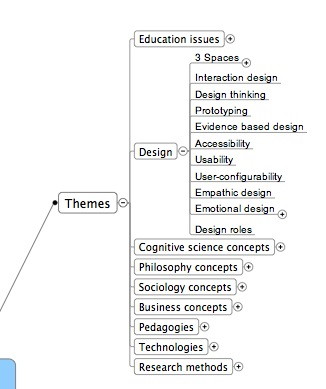
The Pedaogogies node lists existing paradigms with which I can seek such connections and contrasts:
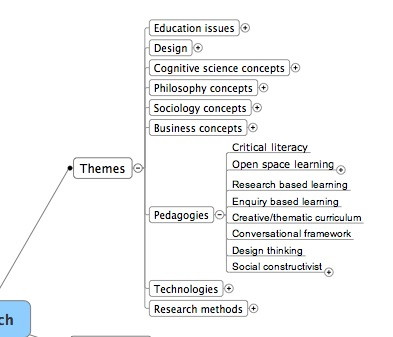
All of these concepts and issues appear within the literature that I am pursuing. Literature records on the left hand side are tagged using terms from the right hand side. As I proceed, I will be able to see areas that need more investigation (using icon markers to identify priorities).
Finally, I will be constructing new ideas and arguments in the Conjectures node. I expect this to become more expansive, detailled and tightly argued as I step through iterations of the discovery-prototype-test process. The Experiments and Investigations node will contain details of formal approaches to evaluating my conjectures:
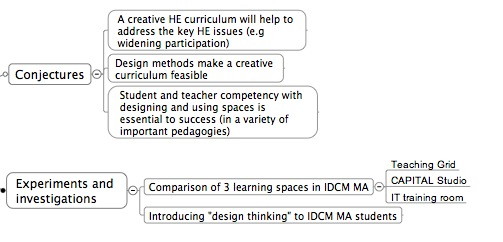
Over time the literature base will grow, but also become more focussed as the need to support very specific conjectures, experiments and investigations becomes more prominent - shifting from an "inspiration" bias towards "implementation" (to use the "design-thinking" paradigm).
August 17, 2009
Use of microblogging (Twitter) as a research tool
I've just read an interesting article on the use of Twitter as a tool for building narrative representations of the learner experience. It is by Elizabeth Aspden and Louise Thorpe of Sheffield Hallam University, who are researching informal study patterns (i.e. outside of schedules classroom hours) and how students choose and use different learning spaces.
An account of the method was given in a recent edition of Educause Qaurterly1. They describe how they recruited 15 students for the study. Each student recorded an account of their use of learning space, at least 3 times a day. This was complemented with 3 longer summaries each week, and a final reflective interview.
Out of this they built a series of narratives2 outlining a typical day in the life of each student. For example, in Eric's story, we learn that he frequently uses empty classrooms as quiet on-campus study space. Imagine what might happen if, through a change in policy, those classrooms were to be locked when not in use.
This method sounds promising, and I think I will try to use it in my own research. How might it develop in the future? Imagine the students using a wifi enabled multimedia microblogging system to record their events: text, photos, video of their experiences immediately posted for access by the researchers. Come on Apple, build us a iPod Touch with a camera!
________________
1 Aspden, E. J. & Thorpe, L. P. "Where do you learn?": Tweeting to Inform Learning Space Development, Educause Quarterly Magazine, Volume 32, Number 1, 2009, http://www.educause.edu/EDUCAUSE+Quarterly/EDUCAUSEQuarterlyMagazineVolum/WhereDoYouLearnTweetingtoInfor/163852 [Accessed 17/08/2009]
2 Informal Learning group, Sheffield Hallam University, Informal Learning: Scenarios, http://shulearningspaces.wordpress.com/informal-learning-scenarios/ [Accessed 17/08/2009]
July 27, 2009
First experiment with un–obtrusive recording of student personal state descriptors
Follow-up to Personal state descriptors for case studies from Inspires Learning - Robert O'Toole
The method previously described has now been tested in a 3 hour session. The aim, to reiterate, is to track changes in the emotional, physical, intellectual and social states of the students (self-reported) at key points - for example, when moving from one spatial configuration to another.
My first experiment aimed simply to test whether the approach is sufficiently un-obtrusive. I haven't really considered the effectiveness of the set of decriptors that I am working with.
At three key points during the session, as we moved between different phases of the session and different seating arrangements, each student selected from a list of words plotted on an A4 sheet and organised into a quick-to-scan concept map. This worked well. The students were happy to complete the forms, despite being engaged in an interesting and challenging activity. I have now compiled the results. They are quite uniform, as the session was not very diverse. However, there are some interesting patterns to spot. The students found the location, the Teaching Grid, to be comfortable throughout.
|
|
Sample point 1 |
Sample point 2 |
Sample point 3 |
|
|
|||
|
Social |
Communicative: 3 |
Communicative: 4 Sharing: 3 |
Receptive: 3 |
|
|
|||
|
Physical |
Comfortable: 4 |
Comfortable: 4 |
Comfortable: 3 |
|
|
|||
|
Intellectual |
Challenged: 4 |
Challenged: 4 |
Inspired: 5 |
|
|
|||
|
Emotional |
Calm: 4 |
Happy: 5 |
Happy: 3 |
 Robert O'Toole
Robert O'Toole

 Please wait - comments are loading
Please wait - comments are loading





